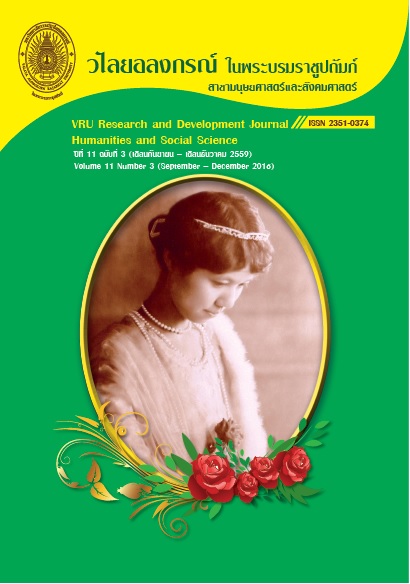นโยบายการให้บริการจังหวัดอัจฉริยะของประเทศไทย
Main Article Content
Abstract
บทความนี้เป็นการกล่าวถึงการให้บริการจังหวัดอัจฉริยะในประเทศไทย ซึ่งกล่าวถึงความเป็นมาจุดเริ่มต้นของแนวคิดที่นำมาประยุกต์เพื่อกำหนดนโยบาย รวมไปถึงผลของการนำนโยบายจังหวัดอัจฉริยะไปปฏิบัติซึ่งพบว่าจุดเริ่มต้นของโครงการจังหวัดอัจฉริยะ หรือจังหวัดอัจฉริยะต้นแบบที่จังหวัดนครนายก เป็นโครงการที่ดำเนินการโดยการนำเอาเทคโนโลยีสารสนเทศและการสื่อสาร (ICT) รวมทั้งระบบการบริหารจัดการที่มุ่งเน้นคุณภาพ โดยการนําเทคโนโลยี ICT มาปรับใช้ทั่วทั้ง จังหวัด ซึ่งมีแบบอย่างจากแนวคิดเมืองอัจฉริยะจากต่างประเทศเป็นแม่แบบ และเมื่อนำมาใช้แล้วพบว่ามีปัญหาและอุปสรรคในด้านมีนโยบายไม่ชัดเจน ไม่มีความพร้อม ขาดความเข้าใจ งบประมาณไม่เพียงพอ โครงสร้างพื้นฐานไม่พร้อม แนวทางปฏิบัติไม่เป็นรูปธรรม อนึ่งเมื่อโครงการสิ้นสุดลงได้มีการกลายร่างของนโยบายไปเป็น Smart City จังหวัดภูเก็ต Smart City เชียงใหม่ และSmart City บางแสน
This paper addressed Thailand’s first “Smart Province” Project Initiative which Nakhon Nayok was selected to be the pilot province for the whole country. This initiative was the key concept to formulate, adopt and implement the Smart Province Policy ultimately. According to demonstration of Smart Cities around the World, the smart province concept was developed and adapted for Thailand. The main objective of the Smart Province Pilot Project was aiming to use of advanced Information and Communications Technology (ICT) to improve the quality of Citizens’ lives with convenient services and more effective administration throughout Nakhon Nayok. However, during the implementation stage, there were some obstacles such as unclear of the policy, rack of readiness, rack of understanding, insufficient budget, poor infrastructure, and rack of concrete guidelines. Nonetheless, once, the Smart Province Pilot Project has ended, the new draft policy later was formulated called “Smart City” Project Policy which focused on Phuket, Chiang Mai, and Ban San accordingly
Article Details
ลิขสิทธิ์บทความวิจัยที่ได้รับการตีพิมพ์เผยแพร่ในวารสารมนุษยศาสตร์และสังคมศาสตร์ วไลยอลงกรณ์ ในพระบรมราชูปถัมภ์ ถือเป็นกรรมสิทธิ์ของคณะมนุษยศาสตร์และสังคมศาสตร์ มหาวิทยาลัยราชภัฏวไลยอลงกรณ์ ในพระบรมราชูปถัมภ์ ห้ามนำข้อความทั้งหมดหรือบางส่วนไปพิมพ์ซ้ำ เว้นแต่จะได้รับอนุญาตจากมหาวิทยาลัยเป็นลายลักษณ์อักษร
ความรับผิดชอบ เนื้อหาต้นฉบับที่ปรากฏในวารสารมนุษยศาสตร์และสังคมศาสตร์ วไลยอลงกรณ์ ในพระบรมราชูปถัมภ์ เป็นความรับผิดชอบของผู้นิพนธ์บทความหรือผู้เขียนเอง ทั้งนี้ไม่รวมความผิดพลาดอันเกิดจากเทคนิคการพิมพ์
References
ทศพร ศิริสัมพันธ์. การวางแผนเชิงกลยุทธ์. คณะกรรมการปฏิบัติระบบราชการ. สำนักนายกรัฐมนตรี, 2539.
รายงานสรุปสาระสำคัญนโยบายของปลัดกระทรวงเทคโนโลยีสารสนเทศและการสื่อสาร” กระทรวงเทคโนโลยีสารสนเทศและการสื่อสาร วันจันทร์ที่ 28 ตุลาคม 2556
ศุภชัย ยาวะประภาษ. (2545). นโยบายสาธารณะ. กรุงเทพฯ: สำนักพิมพ์จุฬาลงกรณ์มหาวิทยาลัย.
สมบัติ ธำรงธัญวงศ์. (2551). นโยบายสาธารณะ : แนวความคิด การวิเคราะห์ และกระบวนการ.พิมพ์ครั้งที่ 18. กรุงเทพฯ : สำนักพิมพ์เสมาธรรม.
สมบัติ ธำรงธัญวงศ์. (2546). นโยบายสาธารณะ (พิมพ์ครั้งที่ 9). กรุงเทพมหานคร:สำนักพิมพ์เสมาธรรม.
Brown, L. J., Dixon, D. & Gillham, O. (2009), Urban Design for an Urban Century: Placemaking for People, New Jersey: John Wiley & Sons, Inc.
Batty, M., Axhausen, K.W., F., Pozdnoukhov, A., Bazzani, A., Wachowicz, M.,Ouzounis, G., & Portugali, Y. (2012), Smart cities of the future: The Europoean Physical Journal Special Topics.
Brooker, D. (2012), “Build it and they will come”? A Critical examination of utopian planning practices and their socio-spatial impacts in Malaysia’s “intelligent city”, New York: Routledge.
Castelnovo, W., Misuraca, G., & Savoldelli, A. (2015), Smart Cities Governance: the need for a holistic approach to assess urban participatory governance. Social Science Computer Review Journal
Deakin, Dameri, R.P. & Rosental-Sabrous, C. (eds). (2014), Smart City: How to Create Public and Economic Value with High Technology in Urban Space, Switzerland, Springer International Publishing.Department for Business, Innovation and Skills, UK 2013: 1
Dror, Donnelly, J. H., Gibson, J. L, & Ivancevich, J. M. (1984) Fundamental of Management.Texas : Business Pub. 2003:3-12)
Dameri, R.P. & Rosental-Sabrous, C. (eds). (2014), Smart City: How to Create Public and Economic Value with High Technology in Urban Space, Switzerland, Springer International Publishing.
Findahl, O. (2013), Svenskarna och internet 2013. Stockholm: SE. https://www.iis.se.docs/SOI2013.pdf.
Gauzin-Muller, D. (2002), Sustainable: Architecture and Urbanism, Berlin: Birkhauser Publishers for Architecture.
Giffinger, R. & Pichler-Milanovic, N. (2007), Smart Cities: Ranking of European Medium-Sized Cities. Vienna, Austria: Centre of Regional Science, Vienna University of Technology.
Horayangkura, V., Jamieson, W., and Malikamarl, P., The Design and Development of Sustainable Cities. Bangkok: Faculty of Architecture and Planning, Thammasat University.Institute of Electrical and Electronics Engineers. (2014), Smart City.
Jackson, M., Gardner, Z. & Wainwright, T. (2011), Location-awareness and Ubiquitous Cities A report to the U- City Research Institute”, Yonsei University, South Korea.
Jenks, M. & Burgess, R. (eds). (2000), Compact Cities: Sustainable Urban Forms for Developing Countries. Spon
Press, Taylor and Francis Group, London.Frost & Sullivan. (2014), Smart Cities.
Jung, H. L., Marguerite, G. H., & Mei-Chih, H. (2013), Towards an effective framework for building smart cities: Lessons from Seoul and San Francisco, Georgia: American Elsevier Publishing Company, Inc.
Mortensen, J., Rohde, F. J., Kristiansen, K. R., Kanstrup-Clausen, M., & Lubanski, M. (eds). (2012), Danish Smart Cities: Sustainable Living in an Urban World, Copenhagen: Copenhagen Capacity.
Smart Cities: Big Data, Civic Hackers, and the Quest for a New Utopia by Anthony M. Townsend Published October 6th 2014 by W. W. Norton & Company (first published October 7th 2013
Stimmel, C. L. (2015). Building Smart Cities: Analytics, ICT, and Design Thinking, New York: Auerbach Publications.
Wu, W. & Gaubatz, P. R. (2013), The Chinese City, New York: Routledge.


